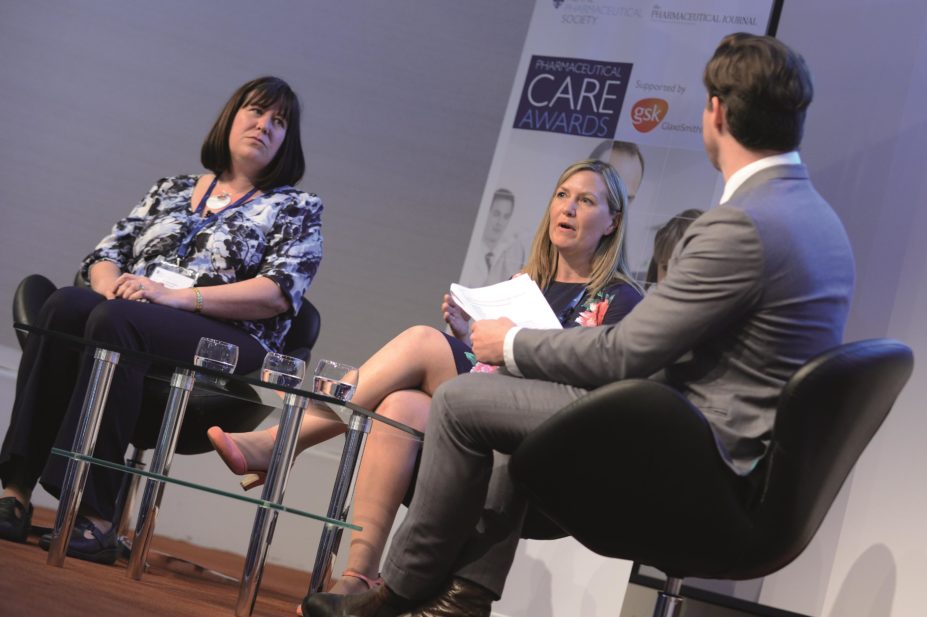
Simon Wright / The Pharmaceutical Journal
Pharmacist support for general practice-based medicines reviews can help to reduce polypharmacy by twice as much as GPs achieve alone, according to the winning project at the Pharmaceutical Care Awards 2015. Older patients are often prescribed multiple medicines with high pill burdens — so-called ‘polypharmacy’ — which can increase their risk of adverse drug reactions. Many of these medicines can be stopped.
The initiative by a team of pharmacists from Coventry and Rugby Clinical Commissioning Group (CCG) won the Pharmaceutical Care Award 2015 at a ceremony in London on 18 June 2015.
Under the project, medicines management pharmacists at the CCG developed an evidence-based protocol to minimise polypharmacy and the associated risk of adverse drug reactions in people 80 years of age or older.
Around 10% of hospital admissions in older people may be caused by adverse drug reactions, and research suggests around 72% of admissions for this reason may be preventable.
Following a successful initial pilot, the team organised medicines reviews at 11 local GP practices for patients aged over 80 years who were taking eight or more medicines. The reviews used the CCG’s new protocol to analyse risk versus benefit for each patient’s medicines. The work formed part of local GPs’ Quality and Productivity domain targets within the Quality and Outcomes Framework in 2013–2014.
In five practices, pharmacists reviewed patients’ medications and discussed any recommended changes with their GP. In the remaining six practices, GPs conducted the medicines reviews alone. Posters and leaflets distributed at the practices encouraged patients to come forward for medicines reviews.
During the project’s timespan, 4,037 medicines taken by 415 patients were reviewed, and a total of 512 items were discontinued.
When GPs conducted the reviews alone, they discontinued on average one out of ten medicines taken by the patients in light of the risk versus benefit analysis. But when pharmacists supported this process, this doubled to two out of ten medicines.
The team said this meant patients were taking only essential medicines, improving patient care by reducing the risk of an adverse drug reaction. Ultimately, this ought to lower related hospital admissions, but demonstrating this proved difficult because of inconsistencies with admissions coding, they said.
The team said the pharmacists had the time to study patient notes and find out when and why medicines were started; to communicate with other health teams about the changes; and to examine factors such as adherence and waste.
Taking part in a Q&A session at the awards, Rosalyne Payne, medicines management pharmacist and member of the winning team, said: “It [polypharmacy] is an area that is beginning to get noticed nationally. It’s also an area… GPs potentially don’t feel confident to undertake anyway, because a lot of their training is about starting drugs. But actually, who says stop? We’re the best placed professional to help support that.”
Fellow team member and medicines management pharmacist Sharon Coane told attendees that the guideline helped to direct the review but that the patient’s involvement was crucial. “When I first started out, I didn’t know whether any of the patients would want to stop their medication, because it was a new thing for us to do,” she said. “We found so many people just wanted to know exactly which medicines they were supposed to be taking and to scupper the other ones that might be causing them problems.”
Coane attributes the success of the scheme to working closely with the GPs. “We were able to have a multidisciplinary approach in the GP practice and work together,” she said. “Some of the GPs I worked with said they see the patients and the drugs all the time, but when a fresh pair of eyes looked at it, they looked at the medication in a completely different way.”
She said the experience helped to give some of the GPs renewed confidence to review more of their patients’ treatments.
Payne said: “You need to have a good relationship with your local GPs because, if you haven’t, it’s not going to work. That’s the number one thing: get their buy-in.
“Then you need to look at communication — how you’re going to communicate with your patients. That’s a process about developing your consultation skills so that you can get the best from your patients… and what they want to get out of the review.”
Payne added that 50% of the GPs they worked with said they would pay to have a pharmacist in their practice.
The team is now working to improve communication between primary and secondary care so that patients’ discontinued medicines are not automatically restarted on admission to hospital. They’re also seeking to hold regular pharmacy clinics in several local practices and to begin addressing polypharmacy in people aged over 75 years. The team is also working more closely with community care and hospital care to address polypharmacy.
You may also be interested in
Long service of members

Membership fees 2022
